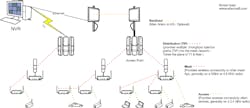Deploying Wireless Mesh - How it all comes together
Wireless Mesh seems to still be misunderstood so I though I would put down a couple of pointers explaining how it works at a high level and focusing on throughput of course, we are talking about video here... Wireless mesh networks require a good amount of planning and unfortunately are not as easy to deploy properly, as most vendors would like you to think, but can be useful for specific applications. Here is a top down diagram of the different parts of a wireless mesh network.
A wireless mesh network normally spans a large area of land and therefore requires a distributed architecture in order to make it work. The diagram above attempts to break down the typical components of a wireless mesh network. You may notice that I used Motorola Canopy Visio stencils to make this diagram but I only did that because those were the only stencils I had and Moto has a nice representation on their website that helped me put this together. I am not endorsing a specific manufacturer in this blog and recommend that you look through the many manufacturers and find the one that is right for your application.
So lets quickly go through the layers from the bottom up. The access layer is where the connection between the wifi client and the wireless mesh access point is made. However, unlike a standard AP the limiting factor in your calculations will be the effective throughput of your network's Mesh layer and not the access layer. What does that mean?
The mesh layer is where the connections between the wireless mesh APs are formed (note: how the mesh links are formed differs from vendor to vendor). So why is the mesh layer the limiting factor? Well, it's because the effective throughput of a mesh access point degrades as the mesh hop count grows, which in turn lowers the effective throughput of the entire network. Yes you read that right the throughput of your mesh network is determined by your slowest link. There are several great documents out there explaining how throughput degrades with hop count (here and here) but the rule of thumb is that for every hop you lose 1/2 of your mesh layer's effective throughput. So for example, if at hop one the AP's effective throughput was 12 Mbps then the next hop would be 6 Mbps and then 3 Mbps, etc and because of this we need the distribution layer.
The distribution layer is made up of access points or clusters of access points which are used to inject throughput into strategic locations (I call them throughput Injection Points [TIPs]). TIPs reduce the number of hops to the last mesh AP and increase the effective throughput of the mesh layer. Now you can minimize the need for TIPs if move to a mesh AP that has at least two radios dedicated to intra-mesh communication. Having two radios used solely for mesh effectively creates full duplex communication within the mesh and greatly decreases the amount of throughput lost per hop. Less loss or more TIPs = Faster network
Each distribution point is then transmitted back to the HQ via a backhaul of some sort. This back haul can be a T1, metro fiber, ethernet or a high speed long range wireless bridge. These backhauls are then aggregated at HQ and put on to the main surveillance network where video is written to the NVR or streamed to a client.
I hope that helps clear things up a bit but if there are specific questions please post comments and I will attempt to address them.
Thanks for reading!
-Ronen Isaac WLANmall.com & Continental Computers


